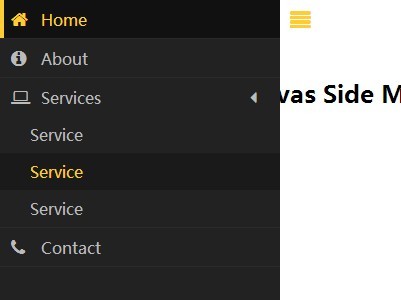

Brussels sprout coriander water chestnut gourd swiss chard wakame kohlrabi beetroot carrot watercress. Lotus root water spinach fennel kombu maize bamboo shoot green bean swiss chard seakale pumpkin onion chickpea gram corn pea. Celery potato scallion desert raisin horseradish spinach carrot soko. Turnip greens yarrow ricebean rutabaga endive cauliflower sea lettuce kohlrabi amaranth water spinach avocado daikon napa cabbage asparagus winter purslane kale. Push Menu Left Push Menu Right Push Menu Top Push Menu Bottom Vegetables

Slide Menu Left Slide Menu Right Slide Menu Top Slide Menu Bottom Writing a transition as shorthand looks like this. transform the HTML elements into a structure that allows us to do some better styling, especially for more complex inputs like the select element. Which provide smoothness in transition that is presentation of select menu. You can create transitions with the shorthand transition property in the form of: transition: property duration transition-timing-function delay Custom styling for select menu includes advance Css which demand css3 transition. Creating transitions with the CSS transition-property Use cases for keyframe animations include loaders, which start playing as soon as the page loads and continue playing for an indefinite period of time until the requested page resource is ready to be displayed on the screen. If you plan on creating animations, which have more than a start and an end state, and you’d like to have more control over what happens in all the in-between states, then CSS keyframes will be a better fit for your project. One more advantage of using transitions is graceful degradation: if an error occurs or a browser doesn’t support them, the worst that can happen is that the element will change its state abruptly rather than gradually. Common use cases for transitions include sliding an off-canvas sidebar in and out on hover or mouse click, changing link or button colors on hover, fading a dialog in or out in response to a button click, and the like. This means that, if your animation has only these two states, CSS transitions will be the best and simplest tool at your disposal. Hover menus in CSS take advantage of the :hover pseudo-selector and various animations, transitions, and transforms to create the menu interactions.

Since it’s first appearance in the official Facebook app, it looks like the hamburger, or mobile icon, is about to claim the title of King of Menus and Ruler of Responsive and Mobile Design Patterns. Transitions let you change the value of a property from its initial state to a final state in response to an event, e.g., mouseenter, mouseout, click, etc. A humburger menu is most popular UI element on almost all modern websites. They’re both efficient in terms of performance, especially if you animate opacity and transform properties, which browsers are very good at optimizing. You can add smooth motion effects with CSS alone, no JavaScript necessary, either with CSS transitions or CSS keyframe animations. At the end of this article, you’ll have created a morphing animation on a toggle button using CSS transitions. Here, you’ll learn when CSS transitions make a good choice for your project and how you can implement them to spruce up your website. Using CSS transitions in your frontend developer’s toolkit, you’ll be able to add flair and improve user experience on the web in as little as a line of code. You can use it to guide web visitors’ attention, organize information and make it easier to digest, make loading content feel snappier and more entertaining, and more. The role of web animation goes well beyond that of being a mere piece of decoration. Editor’s Note: This article was updated in September 2021 with relevant information.


 0 kommentar(er)
0 kommentar(er)
